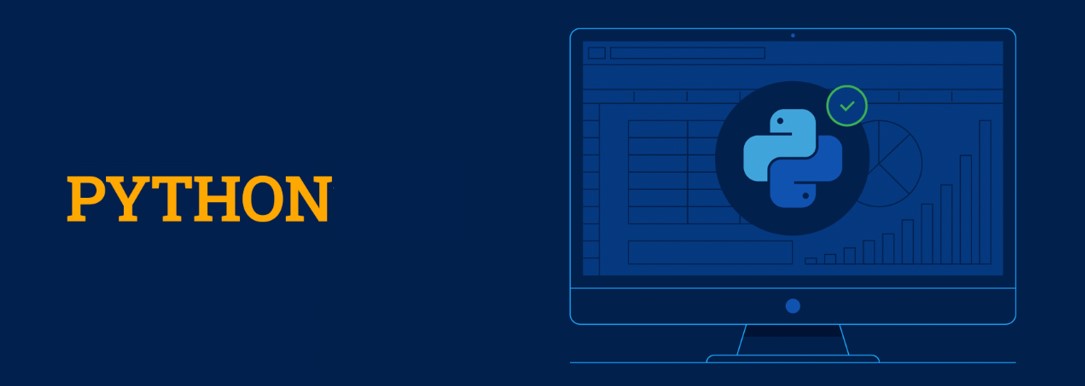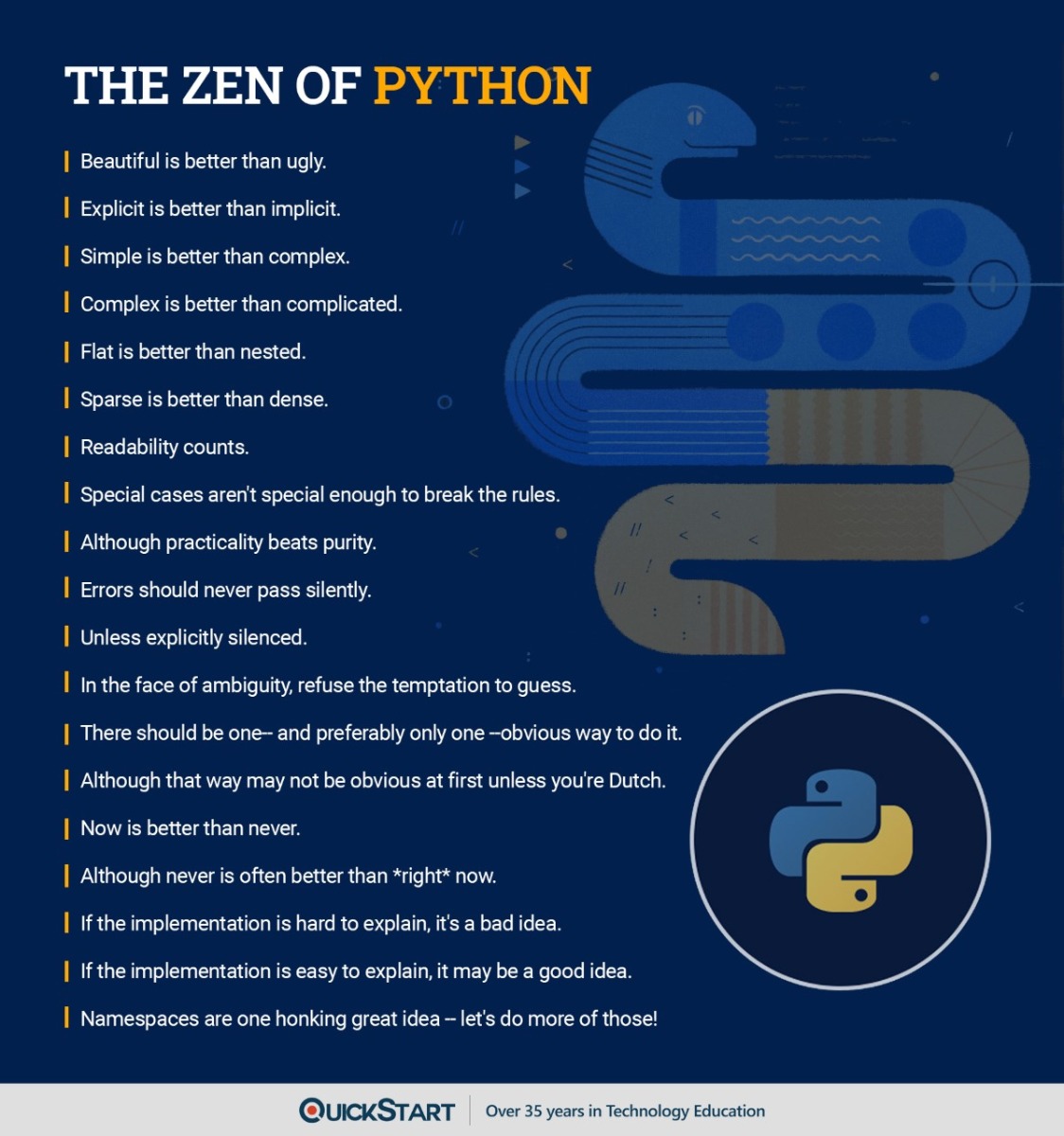
All About Python
Python is one of the most popular programming languages in existence, a distinction it has enjoyed for years. Programmers all over the world use Python for a variety of projects, including artificial intelligence, machine learning, web development, desktop applications, and more.
If you are just embarking on your career as a developer, or if you’re already a developer looking to expand your repertoire, Python should be at the top of your list of languages to learn. Let’s take a look at Python’s history, what it has to offer, and why its future looks so bright.
Python’s History and Philosophy
Guido van Rossum first released Python 0.9.0 in 1991, after a couple of years spent developing it. Python 2.0 followed roughly nine years later, in 2000, and version 3.0 was released in 2008.
Python takes a very different approach to programming than many languages. While many others offer the freedom, and even encouragement, to explore different ways of accomplishing a task, Python is built around the philosophy that there should be a single, best way to do something.
In this sense, Python lives up to its name — just as a Python is a limbless creature, with a single visible body part, the Python language emphasizes that single, best approach. In contrast, many other languages are more like a tree, with many different ways of doing things, much like a tree’s branches.
Python’s philosophy is best summed up in the Zen of Python: 
For many developers, this approach is a refreshing change, one that helps them get down-to-business and be productive, rather than reinventing the wheel all the time. Others may find Python a bit constricting (pun intended).
Python’s Features
Python has many features and abilities that have helped contribute to its long-standing popularity.
Batteries Included
Python is sometimes referred to as a “batteries included” language, meaning that its standard library includes all the necessary elements to get up-and-running and be productive. This can be a major benefit to new programmers who can immediately start working with the language, without having to install a bunch of add-ons or third-party libraries to be productive.
Simple Syntax
Another major advantage of Python, especially for newer programmers, is its simple syntax. The language is much easier to learn than others.
Interpreted Language
Python is an interpreted language, as opposed to a compiled one. With a compiled language, a programmer writes the code and then builds the complete, native application from that code.
In contrast, an interpreted language relies on an interpreter to translate the language’s code into native code for the target computer or platform. This interpretation occurs in real-time. This has both advantages and disadvantages.
In terms of advantages, interpreted languages like Python are often faster to use and develop with, thanks to the real-time translation. Making a change or adding a feature, and then testing it, doesn’t require completely recompiling the application.
In terms of disadvantages, performance can sometimes be a major one. Because the translation is being done on-the-fly, interpreted applications can sometimes struggle to match the performance of a native, compiled alternative.
Garbage Collection
Garbage collection refers to a type of automatic memory management. Specifically, it is the process of recovering memory from functions and program elements that are no longer in use.
Languages that don’t have garbage collection require the programmer to keep track of when a function is no longer being used, and manually recover the memory. Failure to do so can lead to a program using so much memory it eventually crashes the machine.
Because Python has automatic garbage collection, it’s an excellent choice for programmers that don’t want to worry about that aspect of their program’s operation.
Multi-Paradigm Programming
There are a number of programming paradigms that different languages follow. Structural (specifically procedural), object-oriented and functional programming are just some of the most popular options, all of which Python supports.
Structural, including procedural, is one of the oldest paradigms. As its name suggests, it’s defined by a program running various procedures, or sets of actions, on data and returning a result.
Object-oriented programming (OOP) has gained widespread popularity, with virtually all modern languages supporting the paradigm. An OOP language is based around the concept of “classes” and “objects.” These objects are self-contained, having the data, properties and code necessary to perform their tasks.
Python has excellent OOP support, putting it on par with many other modern languages.
Functional programming is gaining in popularity, although it is not as widely used as OOP or structural. Functional programming is based on the concept that functions are first-class citizens, and has its roots in mathematical concepts, with an emphasis on results rather than the process behind those results.
Python’s flexible, multi-paradigm approach is certainly a major advantage for the language, allowing it to adapt to the needs of the programmer.
What Is Python Used For?
Python’s power is on full display when considering the wide variety of applications the language is used for, as mentioned at the outset.
Artificial Intelligence and Machine Learning
Artificial intelligence (AI) and machine learning (ML) are two of the main types of projects Python is used on. In fact, the language is widely considered to be one of, if not the, best choice for this kind of development.
Despite Python’s “batteries included” approach, the language is also very extensible, since it’s able to use other libraries to add features. Because the language has been popular among AI and ML developers for some time, there are a number of Python libraries that have been created specifically for those markets.
If you’re interested in learning more about AI and ML, check out UC Santa Barbara’s Artificial Intelligence and Machine Learning Bootcamp. This bootcamp can help you jumpstart a career in one of the world’s most exciting industries.
Web Development
Python is an extremely popular language for back-end web development. Django, Flask, Web2Py, Pyramid, and Bottle are some of the frameworks used with Python in web development.
Here again, the language’s simple syntax and speed of programming make it a popular choice, especially in an industry as fast-paced as web development.
To learn more about web development, and the opportunities available, check out QuickStart’s university Web Development Coding Bootcamp.
Desktop Applications
While Python is most often thought of in terms of web or AI and ML development, it is often used for desktop apps as well. Many Linux applications are built with Python.
Thanks to modern frameworks, such as Tkinter, developers can use Python to create cross-platform GUI (graphical user interface) programs for all the major platforms.
Mobile Development
Similarly, Python is an increasingly popular choice for mobile development. Kivy is a framework that is cross-platform, supporting Linux, Windows, OS X, Android, iOS, and Raspberry Pi. Most importantly, for mobile development, it also supports multi-touch interfaces.
Data Mining and Analysis
Python is a popular choice for data mining and analysis. Much like AI and ML development, there are a number of external libraries aimed at data mining. Combined with Python’s other strengths, this makes the language an ideal choice for data-intensive tasks.
Is Python Right for You?
Without a doubt, Python has many advantages over other available languages. The language is used in a wide array of industries and is the leading choice in many of them. It’s little wonder Python has been in the top ten most popular languages since 2003.
As a result of its strengths, and especially its role in cutting-edge industries, Python promises to be in high demand for decades to come. This will ensure developers a high degree of job security and return on their investment for learning Python.
If you'd like to learn more, check out QuickStart's university partners and their bootcamps in data science, cybersecurity, AI/ML, and more. QuickStart offers certificates in IT courses from universities such as University of California, Santa Barbara; University of Texas, Arlington; JMU, Hofstra University, and more.